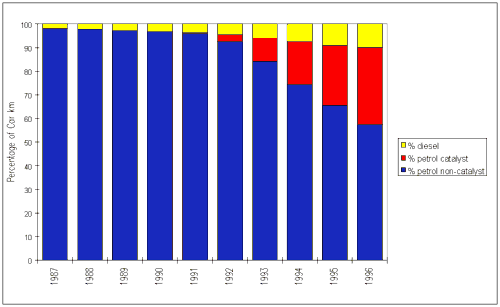

The two major sources of nitrous oxide emissions in the UK are agricultural soils and the manufacture of adipic and nitric acids. Lower levels of emissions arise from combustion processes in the power generation sector and from road transport (Table 2.6 and Figure 2.7).
| 1990 | 1991 | 1992 | 1993 | 1994 | 1995 | 1996 | 1996% | |
| By UNECE category | ||||||||
|---|---|---|---|---|---|---|---|---|
| Comb. in Energy Prod & Transf. | 6.3 | 6.3 | 6.0 | 5.6 | 5.7 | 5.9 | 6.1 | 3% |
| Comb. in Comm/Inst/Resid/Agri | ||||||||
| Domestic | 0.7 | 0.8 | 0.7 | 0.8 | 0.7 | 0.5 | 0.6 | 0% |
| Other | 0.3 | 0.3 | 0.3 | 0.3 | 0.2 | 0.2 | 0.2 | 0% |
| Combustion in Industry | 1.6 | 1.6 | 1.7 | 1.5 | 1.4 | 1.3 | 1.1 | 1% |
| Production Processes | 95.3 | 89.1 | 72.0 | 61.3 | 72.6 | 66.1 | 70.3 | 37% |
| Extr./Distrib. of Fossil Fuels | NE | NE | NE | NE | NE | NE | NE | |
| Solvent Use | 0.0 | 0.0 | 0.0 | 0.0 | 0.0 | 0.0 | 0.0 | 0% |
| Road Transport | 3.2 | 3.3 | 3.7 | 4.9 | 6.3 | 7.7 | 9.2 | 5% |
| Other Transp & Mach. | ||||||||
| Off-Road | 2.2 | 2.3 | 2.3 | 2.2 | 2.2 | 2.1 | 2.2 | 1% |
| Other | 1.2 | 1.2 | 1.2 | 1.1 | 1.1 | 1.1 | 1.1 | 1% |
| Waste Treatment & Disp. | 0.4 | 0.4 | 0.3 | 0.3 | 0.3 | 0.3 | 0.2 | |
| Agricult/Forest/Land Use Change | ||||||||
| Animal Wastes | 5.2 | 5.2 | 5.0 | 5.0 | 5.1 | 5.0 | 5.1 | 3% |
| Non Livestock Agriculture | 98.6 | 98.1 | 92.3 | 90.6 | 92.6 | 93.0 | 93.2 | 49% |
| Nature | 0.0 | 0.0 | 0.0 | 0.0 | 0.0 | 0.0 | 0.0 | 0% |
| Total | 215.0 | 208.6 | 185.5 | 173.6 | 188.1 | 183.3 | 189.3 | 100% |

The calculation of emissions from agricultural soils and animal wastes have been considerably extended in the 1996 inventory using the Revised 1996 IPCC Guidelines (IPCC, 1997) and now considers all the following sources:
The emissions from agricultural soils currently account for around 49% of total UK emissions. The most significant sources are fertiliser application and leaching at 26 and 27 kt N2O respectively.
2.4.2 Production processes
Nitrous oxide emissions from adipic acid manufacture (a feedstock for nylon ) and nitric acid manufacture comprise 37% of the total in 1996. The extent of the emission depends on the production of these acids, hence the time series reflects production levels. The UK manufacturer has recently commissioned an abatement unit that should reduce emissions by at least 95%.
2.4.3 Power generation
The contribution from public power generation has been relatively constant between 1990 and 1996 in spite of the trend away from coal towards natural gas combustion.
2.4.4 Road transport
Emissions from road transport are increasing as a result of the increasing numbers of petrol driven cars fitted with three way catalytic converters, since the converters produce significantly larger emissions of nitrous oxide. Between 1990 and 1996, the proportion of the vehicle kilometers with converters has increased from <1% to 33% and emissions have increased by a factor of 2.9 (Figure 2.8). The contribution of road transport to the total is minor but it is important because it is steadily growing in contrast to the other sectors which are declining.
